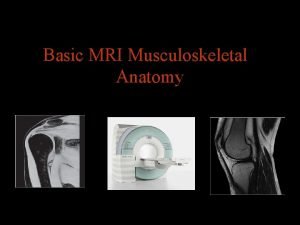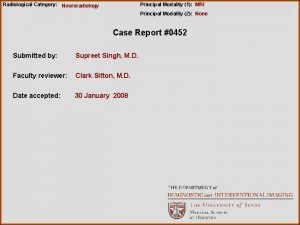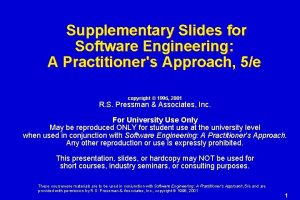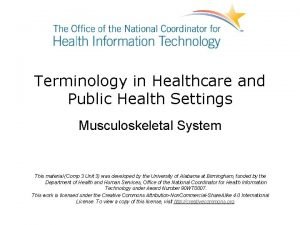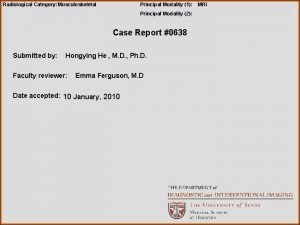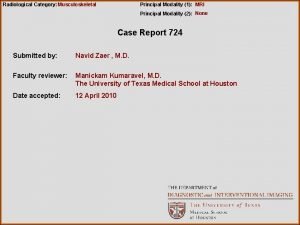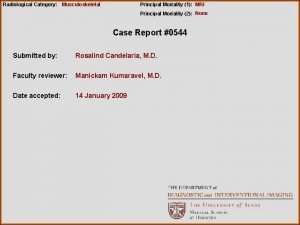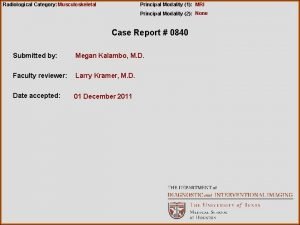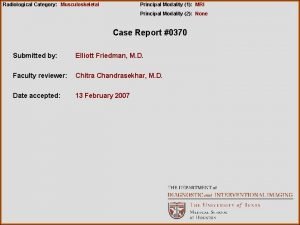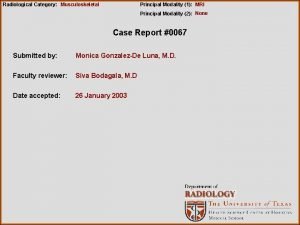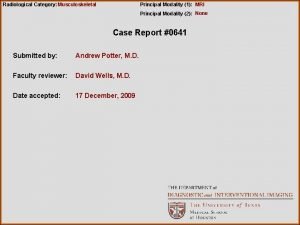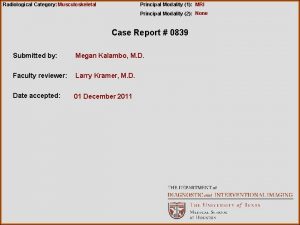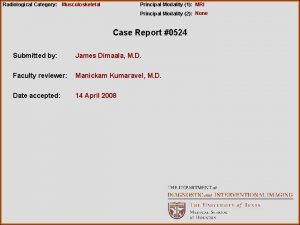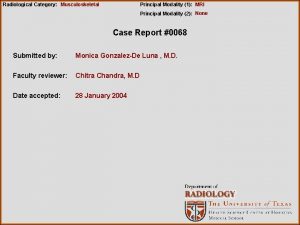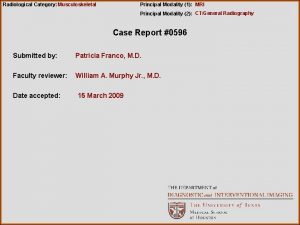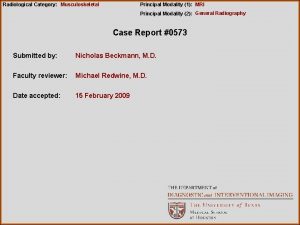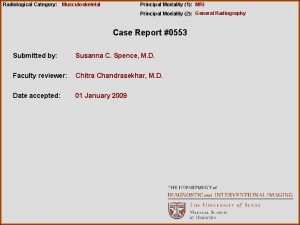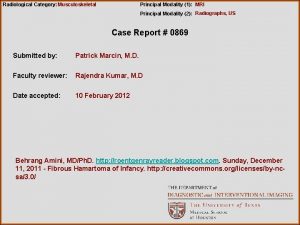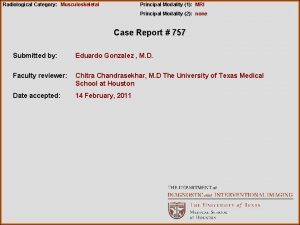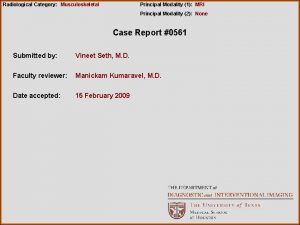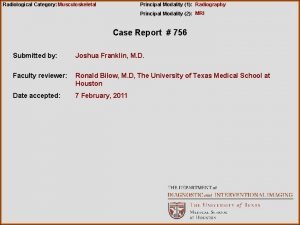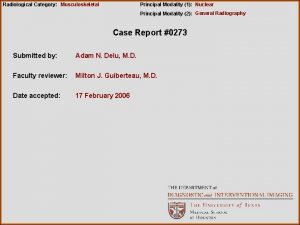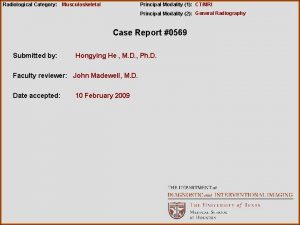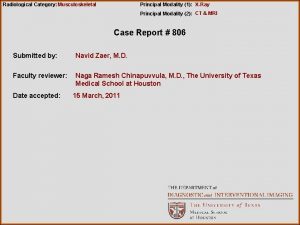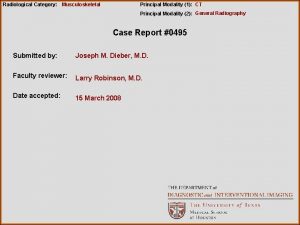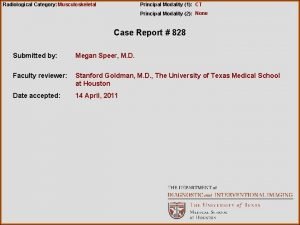Radiological Category Musculoskeletal Principal Modality 1 MRI Principal





























- Slides: 29

Radiological Category: Musculoskeletal Principal Modality (1): MRI Principal Modality (2): Radiographs, US Case Report # 0869 Submitted by: Patrick Marcin, M. D. Faculty reviewer: Rajendra Kumar, M. D Date accepted: 10 February 2012 Behrang Amini, MD/Ph. D. http: //roentgenrayreader. blogspot. com. Sunday, December 11, 2011 - Fibrous Hamartoma of Infancy. http: //creativecommons. org/licenses/by-ncsa/3. 0/

Case History 4 year old male with enlarging, painless, palpable left thigh mass.

Radiological Presentations Greyscale US – axial left posterior mid thigh

Radiological Presentations Color US – axial left posterior mid thigh

Radiological Presentations Left femur lateral radiograph

Radiological Presentations Left femur AP radiograph

Radiological Presentations Coronal T 1

Radiological Presentations Coronal STIR

Radiological Presentations Axial T 1 Axial T 2 Fat Sat Axial T 1 Post

Test Your Diagnosis Which one of the following is your choice for the appropriate diagnosis? After your selection, go to next page. • Intramuscular Lipoma • Fibrous Hamartoma • Lipomatosis of the sciatic nerve • Myxoid Liposarcoma • Lipoblastoma

Findings and Differentials Findings: US – Nonspecific findings with a solid oval shaped mass, with central echogenicity, with a circumferential peripheral hypoechoic rim, which appears discrete from the surrounding muscles. Minimal vascularity of central echogenic region. Radiographs – Fat containing mass of the posterior thigh. No abnormality of the adjacent femur. MRI – Well circumscribed mass within the hamstring complex which is predominantly T 1 hyperintense with multiple thin and several thick septations. There a few central internal areas of low T 1 signal which are T 2 hyperintense and demonstrate minimal post contrast enhancement. Differentials: • Intramuscular Lipoma • Fibrous Hamartoma • Lipomatosis of the sciatic nerve • Myxoid Liposarcoma • Lipoblastoma

Discussion Lipoma • Most common benign mesenchymal tumor composed of mature adipose tissues. Usually asymptomatic. • Most commonly between age of 40 – 60 yrs, range: 5 -75 yrs. • Categorized as deep or superficial. Deep variants include intermuscular, intraosseous and parosteal. • Malignant transformation reported in a few cases. • Imaging Characteristics: ØMass has same imaging appearance as SQ fat. Will follow intensity of SQ fat on every MR imaging sequence. ↑T 1 , ↑ T 2 , suppresses on fat saturation ØSepta measuring < 2 mm in diameter ØCapsule may be incomplete or absent (nonvisible) ØNo enhancement ØMR is best imaging modality for diagnosing lipoma

Radiological Presentations Axial T 1 Axial T 2 fat sat Axial T 1 post fat sat Coronal T 1 Coronal T 2 fat sat Superficial Left Shoulder Lipoma Courtesy James Dimaala, MD

Radiological Presentations Axial T 1 Axial T 2 fat sat Coronal T 1 Fat infiltrating between muscle fibers. Intervening muscle fibers isointense to remaining musculature. * No enhancing septae Axial T 1 post fat sat Infiltrating intramuscular lipoma of vastus lateralis Courtesy of John Madwell, M. D.

Discussion Fibrous Hamartoma • Fibrous Hamartoma of Infancy (FHI) is a rare, usually solitary, benign but rapidly growing superficial lesion most often seen in infants. • No malignant potential. No reports of spontaneous resolution. • More than 90% of the cases occur during the 1 st year of life. • Usually a painless, freely movable mass in the subcutis or dermis that measures less than 5 cm in diameter. May be adherent to fascia but rarely invades underlying muscle. • More common in boys and most frequently found in the axilla, upper arm, upper trunk, inguinal region, and external genital area.

Discussion Fibrous Hamartoma • Histologically, this lesion has three characteristic components: Ø Well-defined intersecting trabeculae of fibrocollagenous tissue Ø Loosely textured islands of primitive mesenchyma, and Ø Mature fat (usually the predominant component). • Imaging Characteristics: Ø Depends on relative proportion of the different tissue components present within the lesion. Ø Fibrous component appears as areas of low signal intensity on both T 1 weighted and T 2 -weighted images, Ø Fatty component shows characteristic high signal intensity on both T 1 - and T 2 -weighted images

Radiological Presentations Combination of soft tissue and fat containing mass within the subcutaneous tissue of the forearm, adherant but superficial to the muscular fascia. Fibrous Hamartoma of Infancy Courtesy Behrang Amini, MD/Ph. D http: //roentgenrayreader. blogspot. com Sunday, December 11, 2011 - Fibrous Hamartoma of Infancy

Discussion Lipomatosis of the Sciatic Nerve • Lipomatosis of nerve, also known as fibrolipomatous hamartoma, is a rare, tumorlike condition characterized by sausage-shaped or fusiform enlargement of a nerve by anomalous growth of fibrofatty tissue. • Most commonly affects the median nerve in upper extremity and its branches, or plantar nerves in foot, but rarely, may affect other nerves as well. Sciatic nerve involvement is much rarer, with only a few case reports. • MRI appearance of lipomatosis of nerve is generally pathognomonic: ØT 1 -weighted images show low intensity, tubular structures representing the individual nerve fascicles. Ø These are surrounded by high signal intensity fat within the expected normal distribution of the nerve. ØThe fat is usually evenly distributed within the affected nerve, uniformly splaying the fascicles away from each other.

Radiological Presentations Post T 2 F. S. T 1 Lipomatosis of the Sciatic Nerve Individual nerve fasicles seperated by fat

Discussion Myxoid Liposarcoma • Liposarcoma is the second most common type of soft-tissue sarcoma exceeded only by fibrous and fibrohistocytic malignancies. • 5 distinct histologic subtypes: well differentiated, dedifferentiated, myxoid, pleomorphic, and mixed type. • Myxoid liposarcoma is the second most common type of liposarcoma. (most common well differentiated a. k. a. atypical lipomatous tumors) • Myxoid liposarcomas are typically large, well-defined, and multilobulated intermuscular lesions. • Myxoid liposarcomas with strong predilection for extrapulmonary soft tissue metastases

Discussion Myxoid Liposarcoma • Most frequently in patients approximately a decade younger than those affected by other types of liposarcoma, with a peak prevalence at the 4 th to 5 th decades of life. • Liposarcomas are extraordinarily rare in patients less than 10 years of age (two cases out of 2, 500 in the AFIP series, both presenting after the age of 2 years). • However, myxoid liposarcoma is the most common type of liposarcoma to affect children, accounting for 76% of liposarcomatous lesions in patients aged 10– 16 years.

Discussion Myxoid Liposarcoma • Histologic composition: Ø Consists of well-delineated lobules of myxoid tissue which is high in water content, with a characteristic arborizing capillary network. ØPrimitive uniform mesenchymal cells with variable numbers of usually monovacuolated and sometimes bivacuolated lipoblasts ØAreas of relatively mature adipose tissue are usually present but sparse (<10% of the lesion overall volume) • Imaging Characteristics: Ø High water content of the lesion is reflected as predominant low attenuation on CT images, ↓ T 1 , and ↑T 2 signal on MRI. ØHowever, pathognomonic feature is adipose tissue seen in the mass. Fat typically constitutes only a small volume of the overall mass size (<10% of the lesion) and is often seen in septa (lacy or linear pattern) or as subtle small nodules in the lesion (illustrated on following page). ØThis pathognomonic appearance of fatty septa or small adipose nodules in a myxoid mass has been reported in 42%– 78% of cases. ØPost contrast enhancement

Radiological Presentations Axial T 1 Axial T 2 Fat Sat Fatty septa and small adipose nodule in a background of myxoid tissue Axial T 1 Post Diffuse enhancement of the capillary rich myxoid component Myxoid Liposarcoma (16 year old male with painless, slow growing mass posterior right thigh)

Discussion Lipoblastoma • Rare benign mesenchymal tumor of embryonal white fat occurring in infancy and childhood. • In the largest series to date, 88% were diagnosed before the age of 3, median age 1 year old, oldest patient 7 years old. • Most commonly painless enlarging superficial or subcutaneous mass of the extremities, less commonly trunk, neck, retroperitoneum and mediastinum. • Classified as: ØLipoblastoma – localized or encapsulated form ØLipoblastomatosis – diffuse or infiltrating form • Natural history is to evolve into mature lipoma.

Discussion Lipoblastoma • Treatment of symptomatic lipoblastoma and lipoblastomatosis is wide surgical resection. • Recurrence develops in 9%– 25% of cases and is largely associated with the infiltrative lipoblastomatosis owing to incomplete resection. • These lesions have no metastatic potential. • Imaging Characteristics: ØVaries depending on the histological extent of fat versus myxoid tissue. ØFat will appear as areas of signal intensity identical to that of subcutaneous adipose tissue with all pulse sequences. ØMyxoid tissue has ↓ T 1 signal, ↑ T 2 signal (reflecting their high water content). These areas also enhance with contrast material, owing to the rich capillary network.

Radiological Presentations Axial T 1 Axial T 2 Fat Sat Myxoid tissue has ↓ T 1 signal, ↑ T 2 signal and post contrast enhancement. Lipoblastoma Axial T 1 Post

Radiological Presentations Axial CT Axial T 2 fat sat Axial T 1 fat sat Post Coronal CT Coronal T 1 fat sat Post Companion case of Lipoblastoma illustrating same imaging features

Diagnosis Lipoblastoma

References Murphey M. Imaging of Musculoskeletal Liposarcoma with Radiologic-Pathologic Correlation. Radio. Graphics. September 2005. 25: 1371 -1395. Murphey M. From the Archives of the AFIP: Benign Musculoskeletal Lipomatous Lesions. Radiographics. September 2004. 24: 1433 -1466 Wong B. Lipomatosis of the sciatic nerve: typical and atypical MRI features. Skeletal Radiology. Volume 35, Number 3: 180 -184 Behrang Amini, MD/Ph. D. http: //roentgenrayreader. blogspot. com. Sunday, December 11, 2011 - Fibrous Hamartoma of Infancy. http: //creativecommons. org/licenses/by-nc-sa/3. 0/ Laffan EE, Ngan BY, Navarro OM. Pediatric soft-tissue tumors and pseudotumors: MR imaging features with pathologic correlation: Part 2. Tumors of fibroblastic/myofibroblastic, so-called fibrohistiocytic, muscular, lymphomatous, neurogenic, hair matrix, and uncertain origin. Radiographics. 2009 Jul-Aug; 29(4): e 36.
 Musculoskeletal mri anatomy
Musculoskeletal mri anatomy Erate category 2
Erate category 2 National radiological emergency preparedness conference
National radiological emergency preparedness conference Radiological dispersal device
Radiological dispersal device Tennessee division of radiological health
Tennessee division of radiological health Center for devices and radiological health
Center for devices and radiological health Mri principal
Mri principal Modality
Modality Low modality examples
Low modality examples Pacs modality workstation
Pacs modality workstation Swd modality
Swd modality Tom arbuthnot
Tom arbuthnot Sensory vs somatic
Sensory vs somatic Deontic modality
Deontic modality Sodality vs modality
Sodality vs modality Cardinality and modality
Cardinality and modality Cardinality and modality
Cardinality and modality Cardinality and modality
Cardinality and modality Modality in software engineering
Modality in software engineering Epistemic modality
Epistemic modality Probalility
Probalility Modality stats
Modality stats Modality
Modality Modality in software engineering
Modality in software engineering Deontic and epistemic modality exercises
Deontic and epistemic modality exercises Modality in software engineering
Modality in software engineering Cardinality and modality in database
Cardinality and modality in database Thank you pictures for presentation
Thank you pictures for presentation Musculoskeletal pronounce
Musculoskeletal pronounce Chapter 6 musculoskeletal system
Chapter 6 musculoskeletal system
